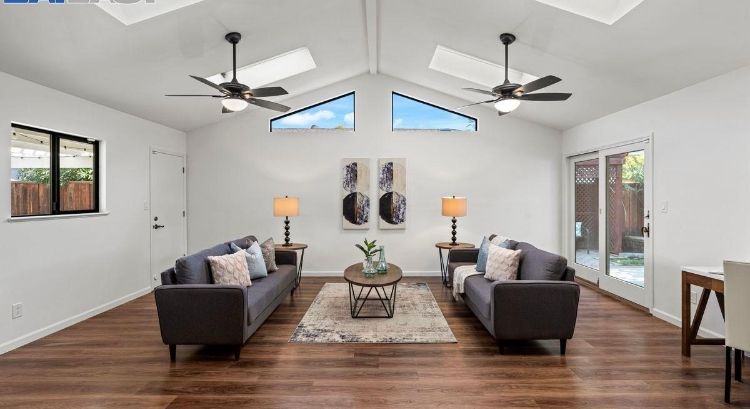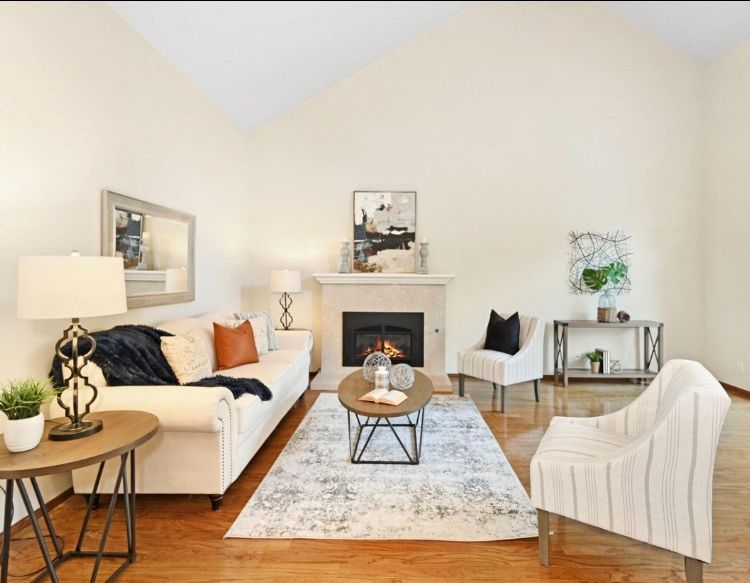The Most Common Home Staging Myths
The Most Common Home Staging Myths—Debunked Why Home Staging in Contra Costa, Alameda, and Solano Counties Is a Must-Have, Not a Maybe Home staging is one of the most powerful tools for selling a home quickly and for top dollar. Yet, many sellers and agents hesitate because of outdated myths. At Elite Staging and Design, we hear the same misconceptions over and over. If you’re selling a home in Contra Costa County, Alameda County, or Solano County, these staging myths could be holding you back from maximizing your sale price. Today, we’re setting the record straight. Myth #1: Home Staging Is Just Decorating Debunked: Home Staging is a Strategic Marketing Tool Home staging is not about decorating. It is about marketing your home for sale. A professional stager designs the space to: ● Highlight the home’s best features, such as natural light and spacious layouts ● Maximize perceived value, making buyers willing to pay more ● Create an emotional connection, so buyers see themselves living there In Contra Costa County, where buyers expect move-in-ready homes in areas like Danville and Walnut Creek, staging makes all the difference. According to the National Association of Realtors (NAR), 81 percent of buyers find it easier to visualize a property as their future home when it’s staged. Myth #2: Staging Is Too Expensive Debunked: Staging Pays for Itself Many sellers think staging is a cost, but it is actually an investment that delivers a strong return. ● Homes that are staged sell for 1 to 5 percent more on average than non-staged homes ● Staged homes sell up to 73 percent faster, meaning fewer price reductions For homes in Alameda County, where buyers are willing to pay a premium in cities like Berkeley, Oakland, and Pleasanton, staging can add thousands to the final sale price. A HomeLight survey found that staging has a 586 percent return on investment. Myth #3: Staging Only Works for Luxury Homes Debunked: Staging Works for All Homes Staging isn’t just for multi-million-dollar estates in Orinda or Alamo. It benefits all price points, including: ● Starter homes in Concord and Vallejo, where staging makes smaller spaces feel bigger ● Mid-range homes in Pleasant Hill and Martinez, where staging helps listings stand out from the competition ● Luxury homes in Blackhawk and Moraga, where staging creates an aspirational lifestyle Even homes in the $200,000 to $500,000 range benefit from staging. A National Association of Realtors (NAR study found that 40% of buyers were more willing to walk through a home they saw online. Myth #4: I Can Just Lower the Price Instead of Staging Debunked: Price Drops Cost More Than Staging Many sellers think, "If my home isn’t selling, I’ll just lower the price." But price reductions can: ● Signal desperation to buyers, leading to lowball offers ● Reduce perceived value, making buyers wonder what is wrong with the home ● Cost more in the long run – a $10,000 price reduction is far more expensive than a $3,500 staging investment In Solano County, where buyers have choices in areas like Fairfield and Benicia, staging makes a home feel like a great value rather than a discounted listing. According to the Real Estate Staging Association, homes that are staged sell nine days faster on average than unstaged homes. Myth #5: My Home Will Sell Anyway – The Market is Hot Debunked: Staged Homes Sell Faster and for More, Even in a Seller’s Market Even in a competitive market, buyers want move-in-ready homes. Staging: ● Attracts more offers, leading to bidding wars ● Creates urgency, encouraging buyers to act fast ● Increases perceived value, so buyers are willing to offer over the asking price In high-demand areas like Lafayette, San Ramon, and Piedmont, staged homes consistently receive stronger offers than unstaged homes. The Bottom Line: Staging is Not an Expense – It’s a Smart Investment Many home sellers and agents in Contra Costa, Alameda, and Solano Counties believe outdated myths about staging. The truth is that staging is a proven marketing strategy that helps homes sell faster and for more money. At Elite Staging and Design, we specialize in staging homes to maximize their appeal and value. If you are planning to sell, let’s discuss how we can transform your home into a buyer’s dream. Contact us today for a consultation. FAQ: The Truth About Home Staging – Myths, Facts, and What You Need to Know Elite Staging and Design | Serving Contra Costa, Alameda, and Solano Counties This FAQ section is designed for voice search, AI search, and hyperlocal SEO, ensuring that homeowners, real estate agents, and home sellers in Contra Costa, Alameda, and Solano Counties find Elite Staging and Design when searching for home staging expertise. 1. Does home staging really make a difference in Contra Costa County? Yes. Staged homes in Contra Costa County—including areas like Walnut Creek, Danville, and Lafayette—sell faster and for more money than unstaged homes. According to the National Association of Realtors (NAR), 81% of buyers find it easier to visualize a property as their future home when it is staged. In competitive markets like Orinda and San Ramon, staging can be the difference between multiple offers and a slow sale. 2. How much does home staging cost in Alameda County? The cost of staging in Alameda County varies depending on the size of the home, location, and level of staging required. On average: ● Condos or smaller homes (under 1,500 sq. ft.) – $2,500 to $4,000 ● Mid-sized homes (1,500 – 3,000 sq. ft.) – $4,000 to $7,500 ● Luxury homes (3,000+ sq. ft.) – $7,500+ In cities like Berkeley, Oakland, and Pleasanton, where home prices are higher, staging is an essential investment to attract high-paying buyers. 3. Do I really need to stage my home if the market is hot in Solano County? Yes. Even in a competitive market, staged homes in Solano County sell faster and at higher prices than unstaged homes. In cities like Fairfield and Benicia, buyers expect move-in-ready homes. If a listing doesn’t present well, it may sit on the market longer or require price reductions. Fact: ● According to the Real Estate Staging Association, staged homes sell 9 days faster on average than unstaged homes. ● In hot markets, staged homes often receive multiple offers, driving the final price up. 4. Can’t buyers just use their imagination? Why does staging matter? Studies show that 81% of buyers find it easier to visualize a property as their future home when it is staged. Staging helps buyers mentally move in and understand the true potential of the space. In areas like Moraga and Blackhawk, where buyers have high expectations, staging creates an aspirational lifestyle that increases perceived value. 5. Does staging work for homes under $500,000? Yes. Staging is not just for luxury homes—it is effective at every price point. In Concord, Vallejo, and Martinez, staged homes get 40% more online views and attract more in-person showings. Buyers shopping in competitive price ranges make decisions quickly, and a well-staged home stands out in listing photos. A National Association of Realtors (NAR study found that 40% of buyers were more willing to walk through a home they saw online. 6. Is home staging expensive compared to a price reduction? No. A price reduction typically costs sellers more than the cost of staging. Example: ● Average price reduction in Contra Costa County: $10,000 to $20,000 ● Average home staging cost: $3,500 to $7,500 By staging first, sellers avoid price cuts and maximize their sale price. 7. What rooms are most important to stage? According to NAR, the top three rooms to stage are: 1. Living Room (39%) – The first space buyers see when they enter the home. 2. Primary Bedroom (36%) – Helps buyers visualize where they will relax. 3. Kitchen (30%) – The heart of the home, where buyers focus on functionality and style. For homes in Piedmont, Alamo, and Lafayette, staging the main living areas makes a significant impact. 8. How long does staging take? The staging process generally takes: ● Consultation & Planning: 1-2 days ● Staging Installation: 1 day for most homes ● Photography & Listing Preparation: 1 additional day In markets like San Ramon and Pleasant Hill, where homes move quickly, Elite Staging and Design can stage a home in one day to meet your timeline. 9. Is virtual staging a good alternative to real staging? Virtual staging can enhance listing photos, but it does not help during in-person showings. ● Real staging transforms the space physically, helping buyers connect emotionally. ● Virtual staging only applies to online listings and does not improve the home’s appeal during showings. In high-value markets like Orinda and Blackhawk, real staging is far more effective in securing offers. 10. How do I book a home staging consultation in Contra Costa, Alameda, or Solano County? At Elite Staging and Design, we offer expert home staging solutions customized for each home. � � Serving Contra Costa, Alameda, and Solano Counties � � Call/Text: +1.925.967.3131 � � Email: https://www.elite-stage.com/contact � � Website: https://www.elite-stage.com/ BELOW THIS LINE ARE INTERNAL NOTES ON SOURCES INTERNAL: STATS & SOURCES: When considering the financial implications of home staging versus a price reduction in Contra Costa County, it's essential to evaluate current data to make an informed decision. Home Staging Costs: The cost of home staging varies based on factors such as the size of the home, the extent of staging required, and the duration of furniture rental. In Walnut Creek, a city within Contra Costa County, the average cost for home staging in 2025 ranged between $115 and $1,156. Price Reduction Implications: In the real estate market, properties that do not attract sufficient buyer interest often undergo price reductions. The median sale price of a single-family home in Contra Costa County was approximately $740,000 as of January 2025. A typical price reduction might range from $10,000 to $20,000, depending on various factors, including the property's initial pricing, condition, and market demand. Comparative Analysis: ● Home Staging Investment: $115 to $1,156 ● Potential Price Reduction: $10,000 to $20,000 By investing in home staging, sellers can enhance their property's appeal, potentially leading to quicker sales at or near the asking price. This proactive approach often mitigates the need for substantial price reductions, resulting in a more favorable financial outcome. Conclusion: Investing in home staging is generally more cost-effective than implementing significant price reductions. By enhancing the property's presentation, sellers can attract more interest and achieve a sale that aligns closely with their financial expectations.


